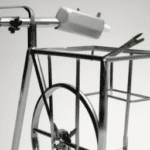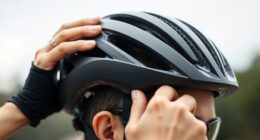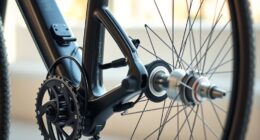Sick of your bicycle’s monotonous appearance? Interested in customizing your bike with your own style? Applying a fresh coat of paint to your bike frame is an excellent method to rejuvenate its look. It’s not only a way to infuse it with unique charm, but it acts as a shield against rust and decay as well.
In this article, we will guide you through the process of painting your bike frame step by step.
First, you need to decide on a design for your bike. Do you want a solid color or a multi-color design? Do you want a glossy or matte finish?
Once you have decided on your design, you need to prepare your bike frame. This involves removing all the parts that you don’t want to get paint on, such as the wheels, pedals, and handlebars. You should also clean the bike frame thoroughly to remove any dirt or grease that might interfere with the painting process.
Now that you have prepared your bike frame, its time to choose the right paint for your design.
Key Takeaways
- Choose a design and color scheme that fits your personal style and preferences
- Properly prepare the bike frame by removing parts, cleaning thoroughly, and sanding for optimal paint adhesion
- Use paint specifically formulated for metal surfaces and apply thin, even coats to avoid drips and bubbles
- Protect sensitive areas with masking tape and add personal touches like decals or stickers for a unique look
Choose Your Design
Now it’s time to choose your design and make your bicycle frame stand out! The first thing you need to consider is the color scheme. You can choose to go with a solid color or a combination of colors. Some popular choices include metallic, matte, or glossy finishes. Keep in mind that the color you choose will ultimately determine the overall look of your bike, so choose wisely.
Once you’ve chosen your color scheme, you can start thinking about graphic elements. This is where you can get creative and add unique designs or patterns to your bike frame. Some popular graphic elements include stripes, dots, flames, or even custom logos. Make sure to choose a design that fits your personal style and that you’ll be happy with for years to come.
With the design chosen, it’s time to prepare your bike frame for painting.
Prepare Your Bike Frame
Before you begin painting your bike frame, it’s important to prepare the surface properly. Start by cleaning the frame thoroughly to remove any dirt, grease, or rust.
Next, sand the frame to create a rough surface that will help the paint adhere better.
Lastly, protect any areas you don’t want painted, such as the headset or bottom bracket, with masking tape or plastic sheets.
By following these steps, you’ll ensure a smooth and long-lasting finish on your bike frame.
Clean the Surface
To properly clean the surface of a bike frame, you’ll need a degreaser and a clean rag. Cleaning techniques are essential to ensure that the surface is free of dirt, oil, and any other contaminants before painting.
The degreaser will help break down any stubborn grime or grease that may be present on the frame. Simply spray the degreaser onto the surface of the bike, and use a clean rag to wipe away any excess. Make sure to work in small sections and use a fresh rag frequently to avoid spreading dirt around.
Once you have removed all the dirt and grease from the bike, you’re ready to move on to the next step: sanding. Sanding will help create a rough surface that the new paint can adhere to. But before that, it is important to ensure that the surface is completely dry.
You can either let the bike air dry or use a clean towel to wipe away any leftover moisture. Remember, a clean and dry surface is key to achieving a smooth and professional-looking paint job.
Sand the Frame
After thoroughly cleaning the surface, it’s crucial to sand the frame to create a rough texture for optimal paint adhesion. This will ensure that the paint adheres well to the surface and doesn’t peel or chip off easily.
When sanding the frame, it’s important to use the right type of sandpaper and proper sanding technique to achieve the desired results. There are different types of sandpaper that you can use, such as coarse, medium, and fine grits. Coarse grit sandpaper is used for removing rust, paint, and other debris from the surface, while medium and fine grits are used for smoothing out the rough surface created by the coarse grit sandpaper.
Proper sanding technique involves using a circular motion with light pressure to create an even texture on the surface. Be careful not to sand too much in one area as it could create a dip or uneven surface. Once you’ve finished sanding, wipe the surface clean with a damp cloth to remove any dust or debris before moving on to the next step of the process.
Protecting any areas you don’t want painted can be done by using masking tape or painter’s tape to cover those areas.
Protect Any Areas You Don’t Want Painted
Shield sensitive spots with some secure and sticky strips of tape. Masking techniques are essential to protect areas you don’t want to paint. Take extra care to cover any logos, decals, or serial numbers that you want to preserve.
This masking process prevents accidental paint overspray, drips, or runs from marring the original finish. Use protective tape to cover the brake bosses, derailleur hanger, bottom bracket, and headset. Apply the tape firmly to ensure a tight seal, so the paint cannot penetrate under the tape.
Once you’ve masked off the necessary areas, you can move on to the next step and choose your paint. Consider the color, finish, and type of paint you want to use. There are numerous options available, including spray cans, powder coating, or traditional brush-on paints.
The choice of paint is crucial to achieving the desired result. With your masked frame, you can now move on to the fun part of the project adding a fresh coat of paint.
Choose Your Paint
Picking the right paint for your bicycle frame is crucial for achieving a professional and long-lasting finish. When choosing your paint, consider the pros and cons of each type. Powder coat paints are durable and long-lasting, but the color options are limited. Spray paints, on the other hand, come in a wide range of colors and finishes, but they may not be as durable as powder coat paints.
To ensure a successful paint job, it’s important to pick a paint that is specifically formulated for metal surfaces, such as a metal primer and topcoat. This will help the paint adhere properly and resist chipping and peeling.
Once you have chosen your paint, be sure to follow the manufacturer’s instructions for application and curing times. With the right paint and proper application, you can achieve a beautiful finish that will protect your bike frame for years to come.
Paint Your Bike Frame
Now that you’ve chosen your paint, it’s time to start painting your bike frame.
First, you need to prepare the frame by cleaning and sanding it. Make sure to remove any previous paint or rust before starting.
Once you have a clean surface, you can start applying your primer. This will help the paint adhere better to the frame and ensure a smooth finish.
After the primer has dried, you can start painting your bike frame. There are many color options available, so choose the one that best suits your style.
When applying the paint, use thin and even coats to avoid drips and bubbles. You can use different painting techniques like spray paint, brush paint, or even powder coating. It’s important to follow the instructions of your chosen paint and technique to achieve the best results.
To add finishing touches, you can add decals or stickers to your bike frame. This will give your bike a unique look and make it stand out.
Alternatively, you can add a clear coat to protect the paint and give it a glossy finish. With these final touches, your bike frame will look like new and ready to hit the road.
Add Finishing Touches
To truly make your ride your own, you’ll want to add some personal touches like custom grips or a unique seat cover. But don’t forget about the finishing touches on your newly painted bike frame. Choosing the right colors and applying decals can really take your bike to the next level.
When it comes to choosing colors, think about what will complement your personal style and the overall look of your bike. Consider using contrasting colors for a bold statement or complementary colors for a more cohesive look. Once you’ve chosen your colors, it’s time to apply decals. Make sure your frame is clean and free of any dust or debris before applying. Use a decal applicator or a credit card to smooth out any bubbles or wrinkles. With these finishing touches, your newly painted bike frame will be ready to hit the road in style.
| Tips for Choosing Colors | Tips for Applying Decals | ||
|---|---|---|---|
| Consider your personal style | Clean your frame beforehand | ||
| Think about complementary or contrasting colors | Use a decal applicator or credit card to smooth out bubbles | ||
| Look for inspiration from other bikes or artwork | Take your time to ensure proper placement | ||
| Don’t be afraid to be bold | Use a clear coat to protect the decal from wear and tear | Overall, applying decals to your bike can be a fun and creative way to personalize your ride and make it stand out from the crowd. |
Frequently Asked Questions
How do I remove old paint from my bike frame before starting the painting process?
To remove old paint from your bike frame, use sandpaper grits between 60-80 to roughen the surface. Alternatively, use chemical paint strippers to dissolve the paint. Be careful to follow safety instructions and wear protective gear.
Can I use regular spray paint for my bike frame or do I need specialized bike paint?
To achieve a smooth and even finish on your bike frame, it’s recommended to use specialized bike paint instead of regular spray paint. Bike paint offers better durability and resistance to weather and UV rays, ensuring a longer-lasting finish. However, if you decide to use spray paint, make sure to properly clean and prepare the surface, use a primer, and apply thin coats to avoid drips and unevenness.
How long does it take for the paint to dry and cure on my bike frame?
You’re probably eager to hit the road with your newly painted bike frame, but patience is key. Painting techniques, humidity, and temperature are factors affecting drying time. Expect it to take at least 24 hours to dry and up to a week to cure fully.
Is it necessary to apply a clear coat over the paint to protect it from chipping and scratching?
To protect your bike frame from chipping and scratching, it’s highly recommended to apply a clear coat. While clear coat alternatives exist, they don’t provide the same level of durability as a clear coat. Without a clear coat, the paint job may not last as long.
What kind of maintenance is required to keep the painted bike frame looking good over time?
To keep your painted bike frame looking good, prevent rust by washing it regularly with soap and water and drying it thoroughly. Wax the frame and touch up small scratches and chips with matching paint.
Conclusion
Congratulations! You’ve successfully painted your bike frame and added your own unique touch to it. The final result is stunning and truly reflects your personality and style.
As you step back to admire your work, you can’t help but feel a sense of pride and accomplishment. The vibrant colors and smooth finish of your bike frame make it look like it’s gliding effortlessly through the air, even when it’s just standing still.
Every curve and angle of the frame is highlighted, making it look like a work of art. You can’t wait to take it out for a ride and show it off to your friends. With your newfound painting skills, you may just start a trend among your fellow cyclists.
Keep up the good work and enjoy your newly painted bike!
















